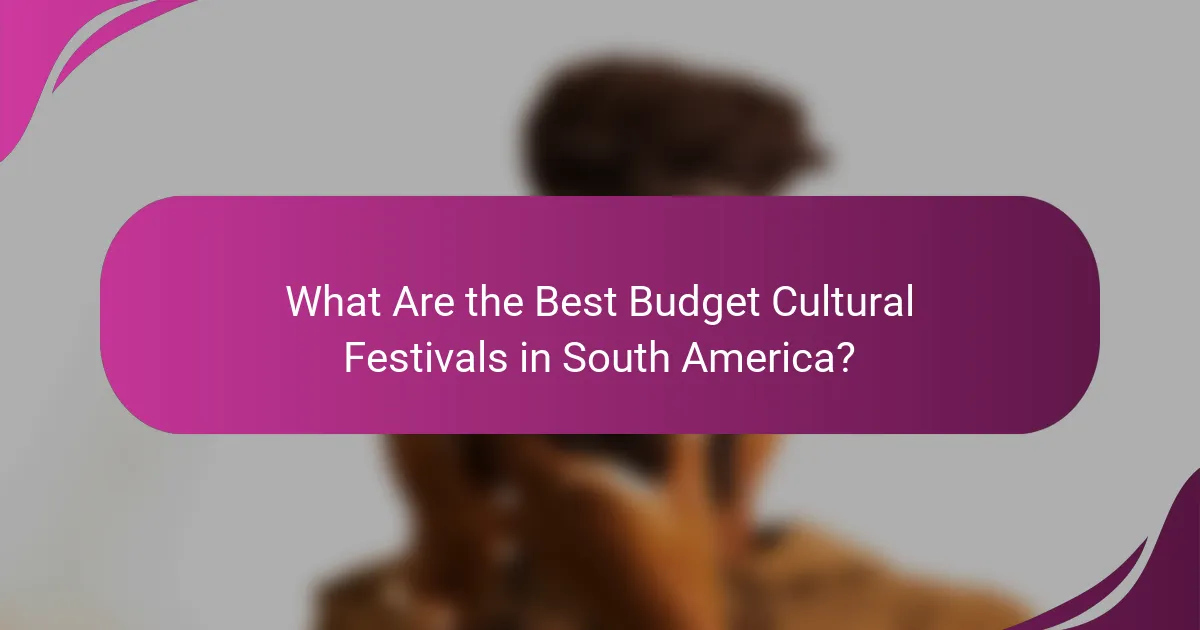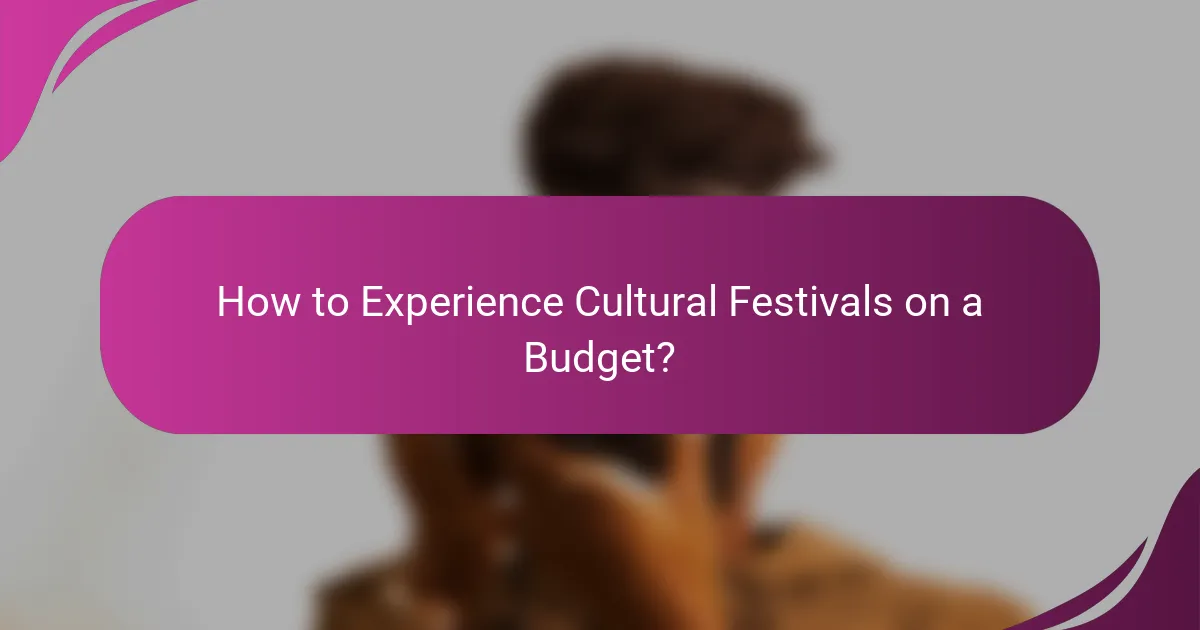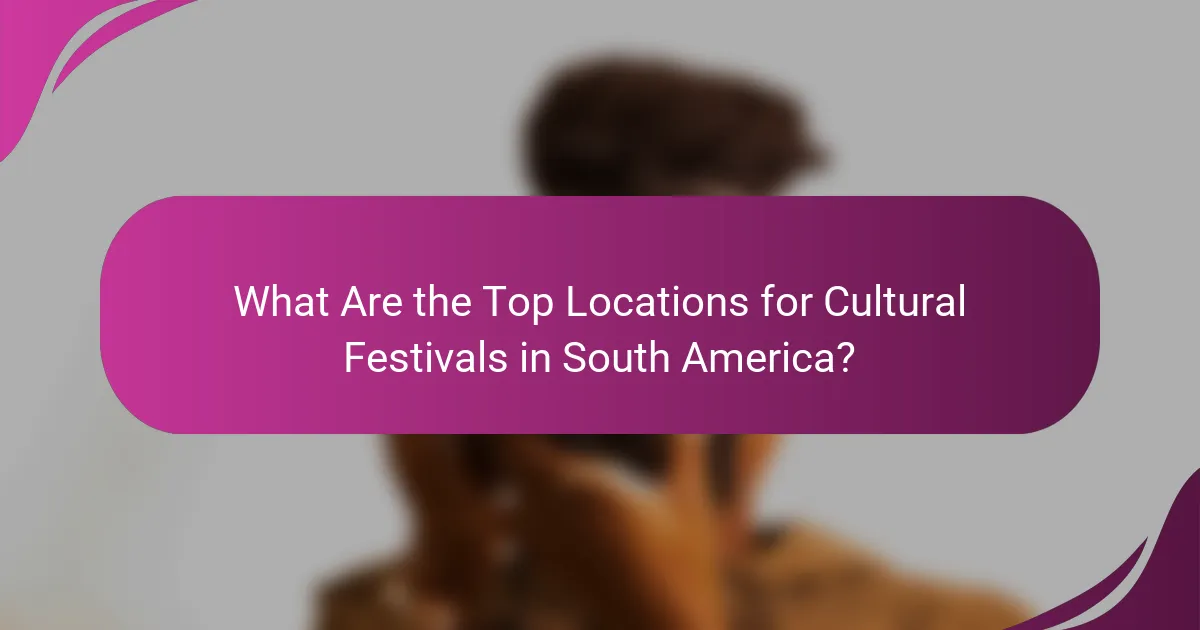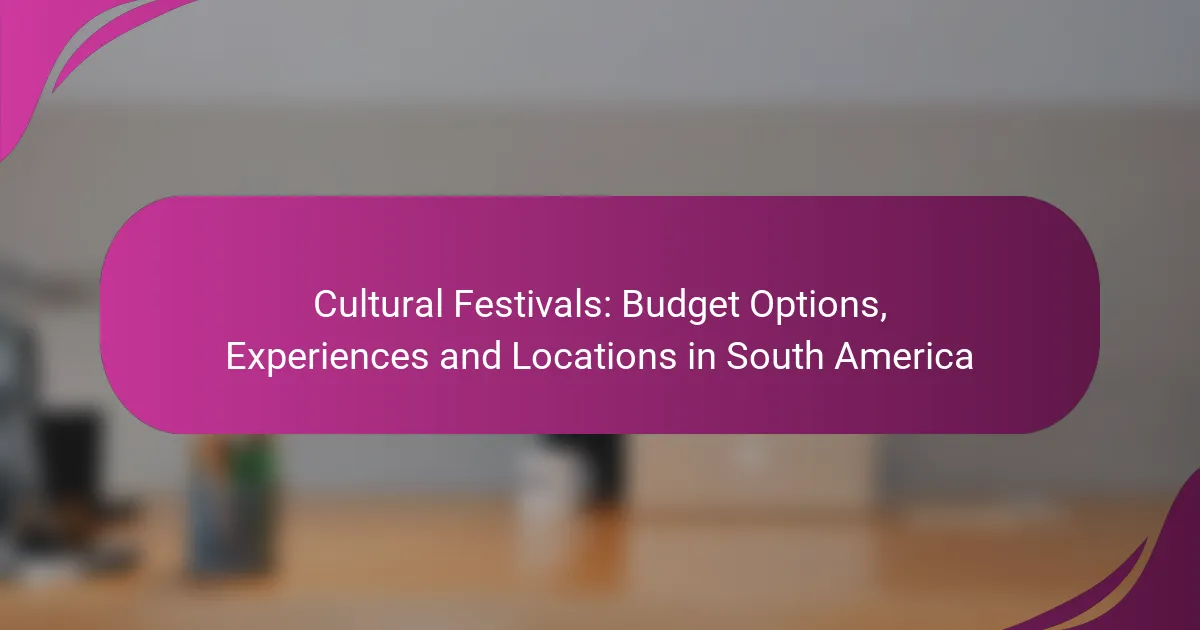South America is a treasure trove of vibrant cultural festivals that highlight its rich heritage and diverse traditions. Many of these celebrations are budget-friendly, featuring free or low-cost events that allow travelers to immerse themselves in local music, cuisine, and customs. With careful planning, you can enjoy these unique experiences in key locations like Brazil, Peru, Colombia, and Argentina without overspending.

What Are the Best Budget Cultural Festivals in South America?
Some of the best budget cultural festivals in South America offer vibrant experiences without breaking the bank. These festivals often feature free or low-cost events that showcase local traditions, music, and cuisine, making them accessible to travelers on a budget.
Carnaval in Rio de Janeiro
Carnaval in Rio de Janeiro is one of the most famous festivals in the world, attracting millions of visitors each year. While ticketed events can be pricey, many street parties, known as “blocos,” are free to attend and offer an authentic experience of Brazilian culture.
To enjoy Carnaval on a budget, plan to participate in the street parties, which feature live music, dancing, and colorful parades. Arriving early to secure a good spot and wearing comfortable clothing is advisable, as the festivities can last all day and night.
Inti Raymi in Cusco
Inti Raymi, or the Festival of the Sun, is a traditional Incan celebration held in Cusco every June. This festival commemorates the winter solstice and features a reenactment of ancient rituals, making it a unique cultural experience.
While there are paid seating options for the main event at Sacsayhuamán, many visitors enjoy the festival from surrounding hills for free. Arriving early is essential to secure a good viewing spot, and participating in local festivities in the city can enhance the experience without additional costs.
Feria de las Flores in Medellín
The Feria de las Flores, or Flower Festival, takes place in Medellín each August and celebrates the region’s rich floral heritage. This vibrant festival includes parades, concerts, and flower displays, with many events open to the public at no cost.
To experience the festival on a budget, focus on attending the free concerts and exhibitions throughout the city. Exploring local markets and street food vendors during the festival can also provide an affordable taste of Medellín’s culinary delights.
Fiesta de la Vendimia in Mendoza
The Fiesta de la Vendimia, or Grape Harvest Festival, is celebrated in Mendoza every March, highlighting the region’s wine culture. The festival features parades, music, and wine tastings, with many activities available for free or at a low cost.
Visitors can enjoy the festivities by attending the free events in the city center and exploring local vineyards that offer budget-friendly tastings. Participating in community events and workshops can provide an immersive experience without significant expenses.
Festival Internacional de Gualeguaychú
The Festival Internacional de Gualeguaychú is an annual carnival held in Gualeguaychú, Argentina, typically from January to March. Known for its lively parades and colorful costumes, this festival offers both ticketed and free events for attendees.
To keep costs down, consider attending the free events along the river or in the town square. Arriving early to secure a good viewing location is recommended, and enjoying local food stalls can enhance the experience while staying within budget.

How to Experience Cultural Festivals on a Budget?
Experiencing cultural festivals on a budget is achievable with careful planning and smart choices. Focus on free events, affordable accommodations, and efficient public transportation to enjoy vibrant celebrations without overspending.
Free events and parades
Many cultural festivals in South America feature free events and parades, allowing you to immerse yourself in local traditions without any cost. For instance, the Carnival in Rio de Janeiro includes numerous street parties known as “blocos” that are open to the public.
Check local festival schedules for free concerts, art exhibitions, and cultural showcases. These events often highlight regional music, dance, and crafts, providing an authentic experience while keeping expenses low.
Local accommodations
Staying in local accommodations can significantly reduce your festival expenses. Consider options like hostels, guesthouses, or homestays, which often offer lower rates compared to hotels. Prices can range from $10 to $50 per night, depending on the location and amenities.
Booking through local platforms or directly with hosts can yield better deals. Additionally, staying slightly outside the main festival areas may provide more affordable options while still allowing easy access to events.
Public transportation options
Utilizing public transportation is a cost-effective way to navigate cities during festivals. Many South American cities have reliable bus and metro systems, with fares typically ranging from $0.50 to $2.00 per trip. Research local transit maps and schedules to plan your routes efficiently.
Consider purchasing multi-day passes if you plan to travel frequently, as these can offer significant savings. Always check for any festival-specific transportation services that may be available to help you reach events easily and affordably.

What Are the Top Locations for Cultural Festivals in South America?
South America is home to vibrant cultural festivals that showcase its rich heritage and diverse traditions. Key locations for these celebrations include Brazil, Peru, Colombia, and Argentina, each offering unique experiences that reflect their local cultures.
Brazil
Brazil is renowned for its lively festivals, with Carnival being the most famous. This annual event, held before Lent, features parades, samba music, and elaborate costumes, attracting millions of visitors. Other notable festivals include Festa Junina, celebrating rural traditions, and Parintins Folklore Festival, highlighting Amazonian culture.
When attending Brazilian festivals, consider booking accommodations well in advance, as prices can soar during peak times. Participating in local events can enhance your experience, so look for smaller, community-driven celebrations that offer a more intimate atmosphere.
Peru
Peru hosts a variety of cultural festivals, with Inti Raymi, the Festival of the Sun, being a standout event. Celebrated in Cusco, this festival honors the Incan sun god with colorful processions and traditional music. Other important festivals include the Virgen de la Candelaria in Puno, showcasing folk dances and music.
Travelers should plan their visits around these festivals to fully immerse themselves in the local culture. Participating in traditional activities, such as dance or craft workshops, can provide deeper insights into Peruvian heritage.
Colombia
Colombia’s cultural festivals are a vibrant expression of its diverse regions. The Barranquilla Carnival is one of the largest, featuring parades, music, and dance that reflect the Caribbean influence. The Flower Festival in Medellín celebrates the region’s floral heritage with stunning displays and cultural events.
To enjoy Colombian festivals, consider exploring local cuisine and crafts during the celebrations. Engaging with local artisans and performers can enhance your understanding of the cultural significance behind each event.
Argentina
Argentina is famous for its tango festivals, particularly the Buenos Aires Tango Festival, which showcases dance performances and workshops. Additionally, the Fiesta Nacional de la Vendimia in Mendoza celebrates the grape harvest with parades, music, and wine tastings, highlighting the country’s viticultural heritage.
When attending festivals in Argentina, be prepared for a lively atmosphere and consider trying local foods and wines to enhance your experience. Engaging with locals can provide unique insights into the traditions and stories behind the celebrations.

What Should You Consider When Choosing a Festival?
When selecting a festival in South America, consider the festival type, timing, and accessibility. These factors will significantly influence your overall experience and enjoyment.
Festival type and theme
Different festivals in South America celebrate various themes, such as cultural heritage, music, food, or religious traditions. For instance, the Carnival in Rio de Janeiro is renowned for its vibrant parades and samba music, while the Inti Raymi in Cusco honors the Incan sun god with traditional rituals.
Choosing a festival that aligns with your interests can enhance your experience. If you enjoy music, look for festivals that feature live performances, while food lovers might prefer events focused on local cuisine.
Timing and duration
Festivals vary in their timing and duration, ranging from a single day to several weeks. For example, the Festival de la Vendimia in Mendoza lasts for about a month, celebrating the grape harvest with various events.
Consider the best time to visit based on your schedule and the festival calendar. Research peak tourist seasons, as some festivals may attract large crowds, impacting accommodation and travel costs.
Accessibility and location
Accessibility is crucial when choosing a festival. Some events are held in remote areas, requiring additional travel arrangements. Ensure that the festival location is reachable by public transport or consider renting a car if necessary.
Additionally, check for accommodation options nearby. Popular festivals may lead to higher prices and limited availability, so booking in advance is advisable. Look for local guesthouses or hostels for budget-friendly stays.

What Are Unique Experiences at South American Festivals?
South American festivals offer vibrant cultural experiences that showcase local traditions, music, and cuisine. Attendees can immerse themselves in lively parades, dance performances, and culinary delights that reflect the rich heritage of each region.
Traditional Music and Dance
Many South American festivals feature traditional music and dance that are integral to the local culture. For example, the Carnaval in Rio de Janeiro showcases samba, while the Inti Raymi in Cusco highlights Andean music and dance. Participating in these performances allows visitors to connect with the cultural roots of the region.
To fully enjoy these experiences, consider joining a local dance workshop or attending a live music event. This not only enhances your understanding of the culture but also provides an opportunity to meet locals and other travelers.
Culinary Experiences
Culinary offerings at South American festivals are diverse and often reflect the local ingredients and cooking methods. Festivals like the Feria de Mataderos in Buenos Aires feature traditional Argentine asado, while the Festival de la Vendimia in Mendoza celebrates wine with tastings and food pairings. Sampling local dishes is a must for any festival-goer.
To make the most of these culinary experiences, try to arrive hungry and explore various food stalls. Engaging with local chefs or vendors can also provide insights into the preparation and significance of the dishes.
Art and Craft Exhibitions
Art and craft exhibitions are common at South American festivals, showcasing local artisans and their work. Events like the Festival del Viento in Colombia highlight traditional crafts such as pottery and weaving. These exhibitions not only promote local talent but also allow visitors to purchase unique souvenirs.
When attending these exhibitions, take the time to interact with the artisans. Understanding the stories behind their crafts can deepen your appreciation and support for the local economy.
Community Engagement
Many festivals emphasize community involvement, offering opportunities for visitors to participate in local traditions. Events like the Fiesta de la Candelaria in Peru invite attendees to join in religious processions and community feasts. Engaging with the community enhances the festival experience and fosters connections with locals.
To engage effectively, consider volunteering or participating in organized activities. This not only enriches your experience but also contributes positively to the community hosting the festival.
